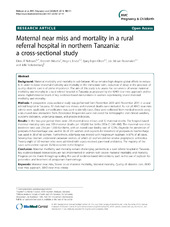| dc.contributor.author | Nelissen, Ellen J. T. | en_US |
| dc.contributor.author | Mduma, Estomih | en_US |
| dc.contributor.author | Ersdal, Hege | en_US |
| dc.contributor.author | Evjen-Olsen, Bjørg | en_US |
| dc.contributor.author | van Roosmalen, Jos JM | en_US |
| dc.contributor.author | Stekelenburg, Jelle | en_US |
| dc.date.accessioned | 2014-03-21T13:44:17Z | |
| dc.date.available | 2014-03-21T13:44:17Z | |
| dc.date.issued | 2013-07-04 | eng |
| dc.identifier.issn | 1471-2393 | |
| dc.identifier.uri | https://hdl.handle.net/1956/7880 | |
| dc.description.abstract | Background: Maternal morbidity and mortality in sub-Saharan Africa remains high despite global efforts to reduce it. In order to lower maternal morbidity and mortality in the immediate term, reduction of delay in the provision of quality obstetric care is of prime importance. The aim of this study is to assess the occurrence of severe maternal morbidity and mortality in a rural referral hospital in Tanzania as proposed by the WHO near miss approach and to assess implementation levels of key evidence-based interventions in women experiencing severe maternal morbidity and mortality. Methods: A prospective cross-sectional study was performed from November 2009 until November 2011 in a rural referral hospital in Tanzania. All maternal near misses and maternal deaths were included. As not all WHO near miss criteria were applicable, a modification was used to identify cases. Data were collected from medical records using a structured data abstraction form. Descriptive frequencies were calculated for demographic and clinical variables, outcome indicators, underlying causes, and process indicators. Results: In the two-year period there were 216 maternal near misses and 32 maternal deaths. The hospital-based maternal mortality ratio was 350 maternal deaths per 100,000 live births (95% CI 243–488). The maternal near miss incidence ratio was 23.6 per 1,000 live births, with an overall case fatality rate of 12.9%. Oxytocin for prevention of postpartum haemorrhage was used in 96 of 201 women and oxytocin for treatment of postpartum haemorrhage was used in 38 of 66 women. Furthermore, eclampsia was treated with magnesium sulphate in 87% of all cases. Seventy-four women underwent caesarean section, of which 25 women did not receive prophylactic antibiotics. Twenty-eight of 30 women who were admitted with sepsis received parenteral antibiotics. The majority of the cases with uterine rupture (62%) occurred in the hospital. Conclusion: Maternal morbidity and mortality remain challenging problems in a rural referral hospital in Tanzania. Key evidence-based interventions are not implemented in women with severe maternal morbidity and mortality. Progress can be made through up scaling the use of evidence-based interventions, such as the use of oxytocin for prevention and treatment of postpartum haemorrhage. | en_US |
| dc.language.iso | eng | eng |
| dc.publisher | BioMed Central | eng |
| dc.rights | Attribution CC BY | eng |
| dc.rights.uri | http://creativecommons.org/licenses/by/2.0/ | eng |
| dc.subject | Maternal near miss | eng |
| dc.subject | Severe acute maternal morbidity | eng |
| dc.subject | Maternal mortality | eng |
| dc.subject | Quality of obstetric care | eng |
| dc.subject | WHO near miss approach | eng |
| dc.subject | WHO near miss criteria | eng |
| dc.title | Maternal near miss and mortality in a rural referral hospital in northern Tanzania: a cross-sectional study | en_US |
| dc.type | Peer reviewed | |
| dc.type | Journal article | |
| dc.date.updated | 2013-08-23T08:38:20Z | |
| dc.description.version | publishedVersion | en_US |
| dc.rights.holder | Ellen JT Nelissen et al.; licensee BioMed Central Ltd. | |
| dc.rights.holder | Copyright 2013 Nelissen et al.; licensee BioMed Central Ltd. | |
| dc.source.articlenumber | 141 | |
| dc.identifier.doi | https://doi.org/10.1186/1471-2393-13-141 | |
| dc.identifier.cristin | 1052137 | |
| dc.source.journal | BMC Pregnancy and Childbirth | |
| dc.source.40 | 13 | |

